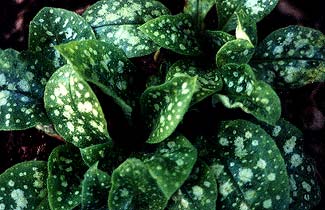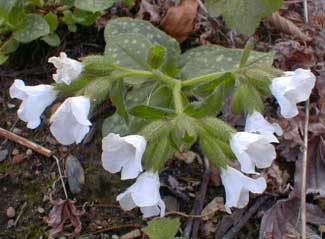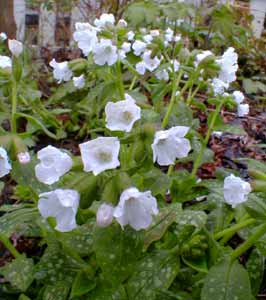
'Sissinghurst White' Lungwort;
& Pulmonaria Myths
"The fair white blossoms of the wood
In groups beside the pathway stand;
But one, the gentle & the good,
Who cropped them with a fairer hand,
Is in her grave,
Low in her grave."
-William Cullen Bryant
(1794-1878)
(1794-1878)
'Sissinghurst White' lungwort was formerly believed to be a cultivar of Pulmonaria officialis but is today regarded as being a naturally hybridized P. saccharata even though still sometimes listed under the former name.
Originally native of Europe & Russia, it is not quite as vigorous & hardy as other cultivars, but all things being relative, it is nevertheless vigorous & hardy. It is a recipient of the Award of Garden Merit for proven garden worthiness, beauty, & ease of growth.
 It likes cool shady areas in moist rich soil, begging little else to grow & remain healthy. In mild winters it is semi-evergreen through most of winter, but in any given year that it does not die back entirely on its own, it will probably need a hard trimming well before winter's end; new leafage usually begins a bit before spring, & flowers occur earlier still.
It likes cool shady areas in moist rich soil, begging little else to grow & remain healthy. In mild winters it is semi-evergreen through most of winter, but in any given year that it does not die back entirely on its own, it will probably need a hard trimming well before winter's end; new leafage usually begins a bit before spring, & flowers occur earlier still.Our two clumps are growing back by February; flowers are getting to be impressive by early March & leaves impressive by late March. Though valued chiefly for its speckled or pokadot leaves, the clusters of white funnel flowers, a few no later than February, a great many in March, are really quite showy & bring light to dark areas of the garden.
When the newly erupting speckled leaves are as yet still rather small, the flowers can seem surprisingly dramatic, & it is only the later flowers (which can linger until April) that are out-competed by the colorful leaves.
While in flower, it might sometimes require deadheading so that the spent flowers do not obscure the attractive leaves. The white petals drop off on their own accord, but the flower stem often needs clipping out of the clump just for looks' sake.
 To propagate, it should be dug up & divided every few years either in spring or autumn, for 'Sissinghurst White' will not reproduce true from its seeds.
To propagate, it should be dug up & divided every few years either in spring or autumn, for 'Sissinghurst White' will not reproduce true from its seeds.The spots on this particular lungwort are faded, but some pulmonarias look like someone came around with white paint & added pokadots. I'm surprised they are not more popular plants, & I sometimes suspect the hideous name "Lungwort" has as much to do with its under-use as anything.
It does have alternate names, but "Lungwort" is so widespread it's hard to overcome. They are so-named because the spots are supposed to resemble a diseased lung, hardly a romantic premise.
It was once believed that by sympathetic magic this resemblance to diseased lungs made it a cure for illnesses of the lungs. Alas, science has not been able to lend any credence to lungwort having such a value. (For more on the belief in floral remedies functioning by means of sympathetic magic, see my article about "Lungwort, Liverleaf, & the Doctrine of Signatures").
The comparison to a diseased portion of the body has certainly been unfair to the beauty of the plant. A Northwest shade garden specialty nursery, Naylor Creek, formerly grew something like twenty-five varieties of lungwort, big upright fountaining ones, small groundcover ones, ones with small white pokadots, others with large round spots or stripes, with purple, blue, white, or pink flowers.
But after years of not being able to forge a market for plants people regarded as looking like diseased lungs, they finally cut back this stock to a few particularly beauteous treasures, & gave over the cultivation space to increasing varieties of the forever popular hostas, & to such dreamy-excellent shade plants as trilliums & jack-in-the-pulpits. They do still offer their personal favorites among pulmonarias, but no longer more varieties than any grower near or far. I can't help but wonder if they were called Pokadot Pretties or Op Art Spatters, more gardeners might collect a dozen different kinds.
The Naylor lads may have given up their attempted niche prematurely, however. In just the last few years, the long neglect of lungworts by the nursery trade seems to have been somewhat ameliorated by companies like Terra Nova in Oregon, with new varieties appearing yearly, & numerous garden critics finally admitting hostas are a bore & lungworts a more varied & interesting choice for those shady areas.
Pulmonaria's array of alternate names that might have been preferred include more than a few that allude to the plant as having some sacred Christian meaning, i.e., Bethlehem Sage, Jerusalem Cowslip, or (as translated from a German name) Our Lady's Milkwort.
The association with Mary is partly because her sacred color is Blue, which is the most common color for many varieties of Pulmonaria, but it is also due to the white spots which gave rise to an interesting legend: When Mary bared her breast to feed the infant Jesus, drops of her milk sprinkled the leaves, which have forever since echoed those spots of Virgin's milk.
In Cheshire P. saccharata is called Lady's Milk Sile, "sile" being a coloquialism meaning "stain," while elsewhere in England P. officinalis is called the Virgin's Milk Drops, elsetimes the Virgin's Honeysuckle in a punning allusion to the suckling of Jesus.
Pulmonaria is elsetimes known as Virgin's Tears or Mary's Tears. The legend explaining this name runs as follows:
Once upon a time the Virgin was walking to Jerusalem carrying her infant, intending to present her son to the Temple. Along the way, she drew aside & sat upon a wellcurb in a garden, where she began quietly to nurse her child.It's tempting to add that such varieties as 'Sissinghurst White,' without the much-legended pink & blue flowers, is Mary's purity.
Unexpectedly she had a vision of seven agonizing passions. At that moment she began to weep without consolation, knowing the entire future fate of her son.
As she shook with sorrow, her son's mouth pulled loose from her teat, & milk dropped onto the leaves of a plant at her feet, while simultaneously her mournful tears sprinkled the flowers.
From that day on, pulmonaria had pink buds because Mary's eyes were red from weeping, blue flowers because her veil was blue, & the leaves were spotted from her milk.
The parallel belief that pulmonaria cured lung diseases became bound up in this sense of the plant's sacredness to Mary, investing it with the miraculous healing ability possessed by herself & her son.
Several other plants with white spots were associated with the same myth, besides a vast number of other plants named for Mary or having myths of the Virgin attached to them. The derivation for all such myths of plantlife's sacredness to Mary actually goes back to ancient Sumeria, for old myths never really die, they transmogrify through cooptation.
In Sumero-Akkadian myth, the goddess Inanna (Ishtar) gave birth to plants after returning with her sweetheart Dumuzi (Tammuz) from the land of the dead, though Dumuzi was soon to be reclaimed by her sister the Queen of the Dead. The Mary myth associating Pulmonaria with the death of Jesus preserves more than one element of the concluding sequences of the tale of The Descent of Inanna & of the death, resurrection, & re-death of Tammuz/Dumuzi.
Even the Jewish widows who wept for Tammuz at the entrance of the Tabernackle [Ezek 8:14], who addressed Hadadrimmon as "the one who is dead" while giving him offerings [Dt 26:14], & for whom they wailed & gashed themselves to insure the fertility of grain & grapes [Hos 7:14], would have found something very familiar about the pulmonaria legend which is ultimately Semitic women's millenia-old mythology coopted by Christians.
P. saccharata 'Purple Haze'